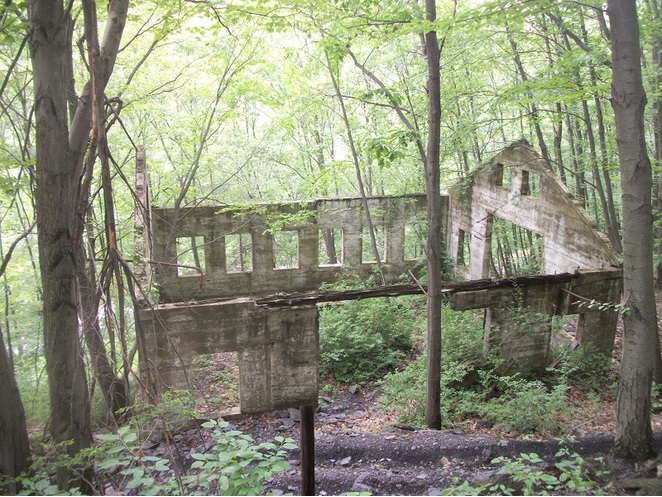Saint Clair, Schuylkill County, Pennsylvania, USAi
| Regional Level Types | |
|---|---|
| Saint Clair | - not defined - |
| Schuylkill County | County |
| Pennsylvania | State |
| USA | Country |
This page is currently not sponsored. Click here to sponsor this page.
Latitude & Longitude (WGS84):
40° 44' North , 76° 10' West
Latitude & Longitude (decimal):
Köppen climate type:
Nearest Settlements:
| Place | Population | Distance |
|---|---|---|
| Saint Clair | 3,004 (2011) | 2.5km |
| Cumbola | 443 (2017) | 3.4km |
| Port Carbon | 1,817 (2017) | 4.1km |
| New Philadelphia | 1,064 (2017) | 4.6km |
| Mechanicsville | 450 (2017) | 5.1km |
Mindat Locality ID:
28811
Long-form identifier:
mindat:1:2:28811:5
GUID (UUID V4):
168da463-3ac6-49ba-9446-aa61f39ff686
Locality is an open pit northeast of Saint Clair. Minerals occur in rock cavities associated with Pennsylvanian anthracite coal beds.
Select Mineral List Type
Standard Detailed Gallery Strunz Chemical ElementsDetailed Mineral List:
| ⓘ 'Chlorite Group' Habit: platy aggregates Colour: green with pearly luster Description: The majority of PA cholrite group minerals have tested positive for a Clinochlore ID (Ref, the Mineralogy of Pennsylvania 1966-1975 Smith pgs76-90), however, the occurence at this locality has not as yet been tested to determine positive species ID. |
| ⓘ Dickite Formula: Al2(Si2O5)(OH)4 Habit: minute crystals Colour: white to nearly clear (clarity visible only under microscope) Description: found associated with quartz crystals |
| ⓘ Pyrophyllite Formula: Al2Si4O10(OH)2 Colour: white to tan Description: from the reference: "Exceptionally preserved plant fossils from St. Clair, Pennysylvania, have long been part of museum and private collections. Fossil fern leaves and stems from the underclay of the Buck Mountain Coal (Reading Anthracite Company quarry), lowest Llewellyn Formation (late Pennsylvanian, Virgilian), combine outer layers of coalified organic material (phytoleim) with strikingly white kaolinite, quartz, and the low-grade metamorphic mineral pyrophyllite in the interior. The surficial dark, coalified material appears to preserve the dense outer layers (cuticle, epidermis, and palisade layer) and some cell walls of fossilized leaves. XRD spectra of separated phytoleim contain graphite peaks. Raman spectra with peaks near 1600 and 1320 cm-1 indicate that the phytoleim is composed of disordered graphitic material. ID/IG ratios from ca. 0.3 to 0.45 are consistent with greenschist facies metamorphic conditions forming the anthracite coal. The interior pyrophyllite is highly crystalline, with large crystals often oriented perpendicular to leaf surfaces. Hydrothermal formation of pyrophyllite requires relatively limited groundwater flow conditions and temperatures between ca. 275 and 350°C. Although many fossil leaves are compressed, some are near original thickness. We infer that the remains were replaced prior to significant burial and compression of the sediment by an early-forming mineral phase, possibly pyrite, which was in turn replaced by kaolinite and then pyrophyllite at higher temperature and pressure. Woody structures such as cuticle and veins, which had resisted replacement by the initial low temperature phase, were coalified at higher temperatures." |
| ⓘ Quartz Formula: SiO2 Habit: prismatic Colour: Clear to Milky white Description: Crystals found in frequent association with dickite |
| ⓘ Siderite Formula: FeCO3 |
| ⓘ Tschermigite Formula: (NH4)Al(SO4)2 · 12H2O |
List of minerals arranged by Strunz 10th Edition classification
| Group 4 - Oxides and Hydroxides | |||
|---|---|---|---|
| ⓘ | Quartz | 4.DA.05 | SiO2 |
| Group 5 - Nitrates and Carbonates | |||
| ⓘ | Siderite | 5.AB.05 | FeCO3 |
| Group 7 - Sulphates, Chromates, Molybdates and Tungstates | |||
| ⓘ | Tschermigite | 7.CC.20 | (NH4)Al(SO4)2 · 12H2O |
| Group 9 - Silicates | |||
| ⓘ | Pyrophyllite | 9.EC.10 | Al2Si4O10(OH)2 |
| ⓘ | Dickite | 9.ED.05 | Al2(Si2O5)(OH)4 |
| Unclassified | |||
| ⓘ | 'Chlorite Group' | - | |
List of minerals for each chemical element
| H | Hydrogen | |
|---|---|---|
| H | ⓘ Dickite | Al2(Si2O5)(OH)4 |
| H | ⓘ Pyrophyllite | Al2Si4O10(OH)2 |
| H | ⓘ Tschermigite | (NH4)Al(SO4)2 · 12H2O |
| C | Carbon | |
| C | ⓘ Siderite | FeCO3 |
| N | Nitrogen | |
| N | ⓘ Tschermigite | (NH4)Al(SO4)2 · 12H2O |
| O | Oxygen | |
| O | ⓘ Dickite | Al2(Si2O5)(OH)4 |
| O | ⓘ Pyrophyllite | Al2Si4O10(OH)2 |
| O | ⓘ Quartz | SiO2 |
| O | ⓘ Siderite | FeCO3 |
| O | ⓘ Tschermigite | (NH4)Al(SO4)2 · 12H2O |
| Al | Aluminium | |
| Al | ⓘ Dickite | Al2(Si2O5)(OH)4 |
| Al | ⓘ Pyrophyllite | Al2Si4O10(OH)2 |
| Al | ⓘ Tschermigite | (NH4)Al(SO4)2 · 12H2O |
| Si | Silicon | |
| Si | ⓘ Dickite | Al2(Si2O5)(OH)4 |
| Si | ⓘ Pyrophyllite | Al2Si4O10(OH)2 |
| Si | ⓘ Quartz | SiO2 |
| S | Sulfur | |
| S | ⓘ Tschermigite | (NH4)Al(SO4)2 · 12H2O |
| Fe | Iron | |
| Fe | ⓘ Siderite | FeCO3 |
Other Regions, Features and Areas containing this locality
North America PlateTectonic Plate
- Appalachian BasinBasin
- SCAB DomainDomain
This page contains all mineral locality references listed on mindat.org. This does not claim to be a complete list. If you know of more minerals from this site, please register so you can add to our database. This locality information is for reference purposes only. You should never attempt to
visit any sites listed in mindat.org without first ensuring that you have the permission of the land and/or mineral rights holders
for access and that you are aware of all safety precautions necessary.








Saint Clair, Schuylkill County, Pennsylvania, USA